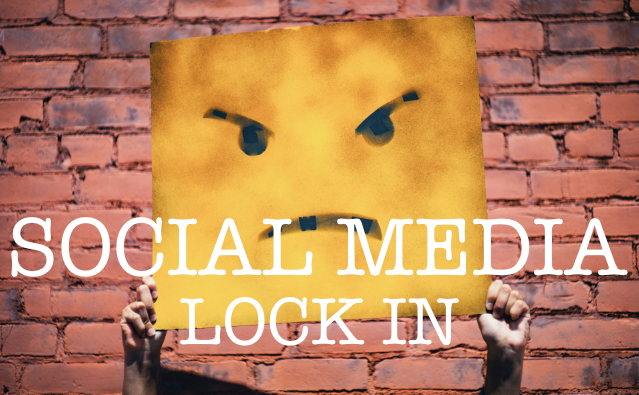The Death of Digital Wanderlust: Why Creators Need Platform Independence
Modern creators are increasingly tethered to major social platforms, trading independence for convenience. But as recent events like the TikTok ban scare show, building your empire on rented digital land comes with serious risks.

Remember when the internet felt like an endless frontier of discovery? When you'd hop from forum to forum, stumbling upon niche communities and passionate discussions about everything from vintage synthesizers to urban farming? Those days seem increasingly distant as content creators and their audiences retreat into the walled gardens of major social platforms.
We're witnessing a dramatic shift in how online communities form and interact. Instead of spreading their presence across various independent forums and websites, today's content creators are consolidating their activities within a handful of major platforms – primarily Instagram, TikTok, YouTube, and Twitter. It's like watching digital nomads settle down into gated communities, trading the adventure of the open web for the convenience and predictability of algorithm-driven feeds.
The Golden Handcuffs of Social Media
The allure is undeniable. With TikTok boasting over 1 billion monthly active users and Instagram not far behind, these platforms offer creators something invaluable: a ready-made audience. Their sophisticated algorithms do the heavy lifting of finding and delivering content to interested viewers – a luxury that independent creators could never achieve on their own.
Modern social platforms have become all-in-one toolkits for creators. Need to sell merchandise? Instagram Shop has you covered. Want to host exclusive content? YouTube's membership features await. Looking to engage with your audience? Twitter's Spaces and Instagram's Live features provide instant connection. This integration eliminates the need for creators to cobble together different services and platforms to reach their goals.
The Dark Side of Digital Dependency
However, this convenience comes at a price. One algorithm change can devastate years of hard work overnight. Platforms favor frequent, consistent posting – often multiple times per day – leading to creator burnout and declining quality. Rather than crafting thoughtful, well-researched content, creators find themselves feeding the endless appetite of the content machine, trading depth for frequency.
The TikTok Wake-Up Call
The recent TikTok ban scare in the United States served as a stark reality check. For approximately 14 hours, as the threat of an immediate nationwide ban loomed, millions of creators faced a terrifying question: What happens when your digital livelihood can vanish with the stroke of a pen?
A $14.7 billion industry in the U.S. alone teetered on the edge, highlighting the dangerous vulnerability of platform dependency. During those tense hours, creators and businesses frantically tried to direct followers to backup platforms, download their content archives, and share alternative contact information. Yet, ironically, even these emergency measures had to be communicated through the very platform they were trying to escape.

Building Digital Resilience
The path to platform independence isn't about abandoning social media entirely—it's about building a sustainable ecosystem where these platforms serve as powerful tools rather than essential lifelines. This requires a strategic approach:
The Hub-and-Spoke Model
Think of social platforms as spokes that lead back to your hub. Use social media for discovery and engagement, but maintain a personal website as your digital home base. Develop an email list – still the most reliable way to reach your audience – and consider podcast platforms for audio content.
Diversify Revenue Streams
Don't let one platform control your entire income. Develop digital products, offer consulting services, create merchandise through independent suppliers, and build subscription-based communities. The goal is to create multiple income streams that can sustain your business even if one platform disappears.
The Long Game
Building platform independence requires patience and strategy. Start with something as simple as a basic website that serves as your digital business card. Add a newsletter signup form, focusing on converting your most engaged followers first. These super-fans become the foundation of your independent community.
Share your journey with your audience. When platform uncertainties arise, use them as teaching moments to explain the importance of direct connection. Build systems that you can maintain without burning out, creating content templates that work across platforms and establishing realistic content calendars.
The Power of Digital Self-Reliance
As we stand at this crucial intersection of content creation and platform dependency, the choice facing creators isn't whether to use social media platforms, but how to use them wisely. The most successful creators of tomorrow won't be those with the most followers on any single platform, but those who've built robust, independent digital ecosystems that can survive—and thrive—regardless of which way the winds of tech giants blow.
The path to platform independence may be longer and more challenging than simply riding the algorithm wave, but it's ultimately more rewarding. It's about building something that's truly yours—something that can't be taken away with a policy change or a government decree.
For those ready to begin this journey, remember: every email subscriber, every direct connection, and every piece of owned content is a step toward true digital resilience. The time to start isn't tomorrow—it's today. Because in the ever-shifting landscape of digital media, the only certainty is change, and the only security is the foundation you build for yourself.
The question isn't whether platforms will change—they will. The question is: will you be ready when they do?




